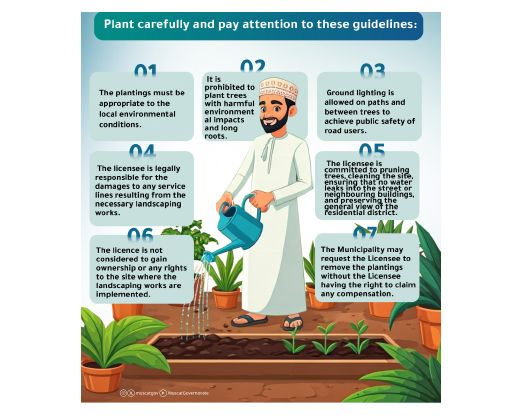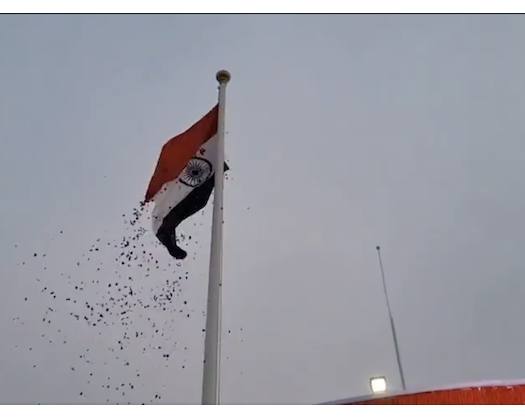Muscat: In its commitment to advancing digital transformation, the Muscat Governorate, representing the municipal sector, has launched a media campaign to promote the ‘Issuance of a minor building permit for landscaping outside the residential building boundaries.’
The objective of this campaign is to enhance public understanding of the service and the associated technical and organizational guidelines.
Organizational Guidelines to Ensure Safety and Consistency.
According to the regulations, a permit is required prior to commencing any landscaping activities outside the residential property lines. Landscaping is permitted only on edges that face streets or valleys, with a mandatory clearance of at least 3 meters for pedestrian and service pathways, in accordance with the approved plans from the Ministry of Housing and Urban Planning.
If the residential property is part of a larger landscaping project, prior approval must be secured from the project management or supervising authority.
A minimum distance of 1.5 meters must be maintained as a corridor to the street to facilitate pedestrian movement, as well as pathways for bicycles and wheelchairs. Additionally, there should be at least a 0.5-meter gap between the external building fence and the planting area to prevent irrigation water from affecting the fence.
The guidelines specify that the total distance from the external fence to the street must be no less than 3 meters. If a distance of 6 meters or more is available, the landscaping area should not exceed 4 meters. In cases where only 2 meters of space is available, only green areas and seasonal flowers are permitted.
Prohibited Landscaping Areas
The regulations outline specific areas where landscaping is not permitted. These include vehicle entrances, zones adjacent to railways or public utilities, pathways for public services, areas near electrical installations, and the shared front space between two adjacent properties at right angles. Additionally, landscaping is forbidden in open spaces not marked on the cadastral map and along the edges facing the intersection of two streets in corner lots, where they should be replaced with green spaces and seasonal flowers.
The regulations also restrict the use of permanent materials for tree fencing. Only side barriers made of curb stones or similar materials, not exceeding 20 centimeters in height from the ground level paved with interlocking tiles or equivalent, are allowed. Plant fencing must not exceed 50 centimeters, while metal mesh fencing can be up to 1.5 meters high for each tree, particularly in areas with a high population of stray animals.
Furthermore, the guidelines require that plantings be appropriate for local environmental conditions, such as high summer temperatures, limited rainfall, low soil fertility, and elevated salinity in certain regions. Planting trees with deep roots or those that could negatively impact the environment and the safety of buildings and public service lines is prohibited. Ground lighting may be installed along pathways and among trees, ensuring the safety of road users. The licensee is legally responsible for any damage to service lines resulting from necessary tree planting activities, which must be conducted manually. The licensee is also required to prune trees, maintain cleanliness on the site, prevent water runoff into streets or neighboring buildings, and uphold the overall appearance of the residential area.
It is important to note that the license does not confer ownership or any rights to the land where landscaping activities are carried out.
The license does not confer ownership or any rights to the site where the landscaping work is carried out.
The Municipality reserves the right to instruct the licensee to remove any plantings that do not comply with municipal regulations or requirements, or to relocate service lines as mandated by relevant authorities or for reasons pertaining to the public interest. Should the licensee fail to remove the plantings within the designated timeframe, the Municipality may proceed with the removal at the licensee's expense, without any entitlement to compensation.
Steps to Apply for a Permit
To obtain the permit, applicants must submit their application online through the Muscat Municipality’s website at www.mm.gov.om or at Sanad Services offices. The process begins with updating the cadastral drawing on the Ministry of Housing and Urban Planning's website, which will automatically include the statement, "Landscaping is permitted in accordance with the relevant municipality's standards." The application must include a letter addressed to the municipality, a commitment to remove the landscaping upon request without seeking compensation, a copy of the identity card, proof of land ownership, the updated cadastral drawing, a detailed plan of the proposed landscaping, and approvals from relevant entities (such as drainage, water, or electricity).
A specialist will review the application, register it online, and schedule a date for a site visit. After the visit, specialists will inspect the site to ensure compliance with municipal requirements, and the permit will be issued within two to five working days.
This service is provided at no cost, with an insurance fee of OMR50.
The Muscat Governorate emphasizes the necessity of obtaining a permit prior to commencing any landscaping activities. Those who fail to comply will face an administrative penalty of OMR100, along with a daily fine of OMR10, capped at OMR200, and will be required to either remove the landscaping or correct the issue.
Before enforcing these requirements, the Municipality may ask for changes or the removal of current landscaping, allowing a two-month period for compliance with the new regulations.
For more details and to submit applications, please visit the official website of Muscat Municipality: www.mm.gov.om.











